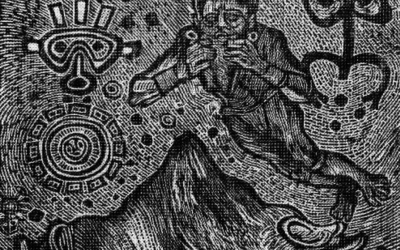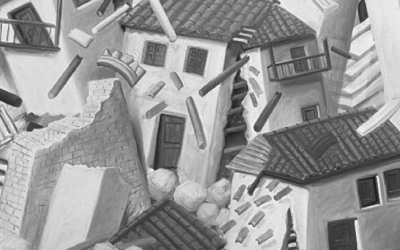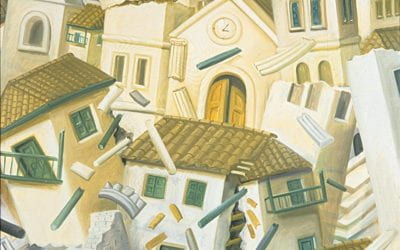Environmental Stress and Rainmaking
Cosmic Struggles in Early Colonial Times
When Europeans first attempted to settle in North America north of the Rio Grande, their confrontations with Indian cultures were marked by cosmic struggles over environmental conditions, particularly rainfall. Christian priests and native religious leaders, however recklessly, both claimed the power to make rain, and this rivalry took on special sharpness in the extreme conditions that characterized the later sixteenth and seventeenth centuries. Recent scientific research has demonstrated that serious recurring drought plagued both northern New Spain and southeastern North America during that time..On July 17, 1588, during the worst three years of drought in eight hundred years, St. Augustine’s governor Pedro Menéndez Marqués wrote home of the hardships his colonists faced: “There has been a very long drought the present year in this part of the world, particularly so in Florida, where not a grain of maize could be planted; and we were in very great distress” (printed in The Historical Magazine, III ,1859, 275-6).
One of the questions posed most often by Indian leaders was whether the Christians might have greater ability to modify the weather through their special relationship with God. At the same time, European Christians firmly believed that American priests had powers and that they could use those powers to produce environmental effects that could harm them. Rainmaking contests offer an important perspective on the struggle between Christianity and American religions because Indians and Europeans understood these effects in the same way. If drought meant that God was angry, that anger fell on Europeans and Indians alike. And every encounter was marked by fear and hope on both sides.
In northern New Spain, Jesuits entered directly into rain contests with leading shamans in struggles of Biblical proportions. Converted Indians sometimes sought out native deities when catastrophe threatened. In one case, the pueblo of Tehueco appealed to a “sorcerer” “to bring rain in “a time of great drought.”“ Despite all his conjuration and ““great promises of abundant water,” “the shaman failed. Rain did come when the Jesuit priest organized a procession in honor of “the true lord of the rain.” Fray Andrés Pérez de Ribas compared this episode to the prophet Elijah’s confrontation with the priests of Baal. Pérez de Ribas coupled his story with one from Tehueco. where “a famous sorcerer” lamented his loss of power: “I do not know what is happening. We are no longer any good at healing. After we were baptized our familiar spirits left us.” (See Andrés Pérez de Ribas, History of the Triumphs of our Holy Faith Amongst the Most Barbarous and Fierce Peoples of the New World, ed. Daniel T. Reff (Tucson, 1999),
Christians knew that they were playing a very dangerous game in demanding God’s intervention on their behalf. Did they fear falling into the sin committed by the Israelites at Massah and Meribah? Afraid that they would not find water in the desert, “the children of Israel…had tempted the Lord, saying, ‘Is the Lord among us, or not?’” Those who tempted God by demanding demonstrations of his power were, according to Hebrews 3:7-19, destined to join those “whose carkeises fell in the wildernes.”
French Jesuits were as willing to make such promises as were their Spanish counterparts. In 1634 at Quebec in the midst of a multi-year famine caused by failure of the snow that facilitated their moose hunt, the Jesuits led by Paul LeJeune fed visiting Montagnais Indians as best they could with “a little feast of peas and boiled flour.”
While the Indians ate, the Jesuits talked to them about Christianity, and the Americans made clear what they expected of God. “As to the proposals we make to them to believe in God, one of them said to me one day, ‘If we believe in your God, will it snow?’ ‘It will snow,’ I said to him. Will the snow be hard and deep?’ ‘It will be.’ ‘Shall we find Moose?’ ‘You will find them.’ ‘Shall we kill some?’ ‘Yes; for as God knows all things, as he can do all things, and as he is very good, he will not fail to help you, if you have recourse to him, if you receive the Faith, and if you render him obedience.’ ‘Thy speech is good,’ answered he, ‘we will think upon what thou hast told us.’ Meanwhile, they go off into the woods, and soon forget what has been said to them.”
And New England’s puritans also engaged in public demonstrations of their ability to call on God, the first being when the Plymouth colonists fasted and prayed for rain “in extreame Drought.” The Narragansett leader Hobbomock who witnessed the prayer service “fell a wondring” at their actions on such a sunny day under a cloudless sky, “and thought that their God was not able to give Raine at such a time as that.” The “poore wretch” was ultimately amazed to see clouds gathering and, as the Pilgrims ended their prayers, a “most sweet, constant, soaking showre. Hobbomock then “fell into wonderment at the power that the English had with their God.” He said, “Now I see that the English-mans God is a good God, for he hath heard you, and sent you Rain, and that without Storms, and Tempests, and Thunder, which usually we have with our Rain, which breaks down our Corn . . . .” From then on favorable weather continued, giving them “a fruitful and liberal Harvest.” In a similar fashion, a cosmic drama marked the coming of Christianity in the arid Southwest. As Juan de Oñate and his men, in the vanguard of the first attempt to found Spanish settlements in New Mexico in 1598, approached the Piros pueblos, according to eyewitness Gaspar Pérez de Villagrá,
It seemed the earth did tremble there, Feeling the great force of the Church Shaking the idols furiously, With horrible, impetuous violence And furious tempest and earthquake.
The priests began to pray and “The Lord, in pity, showed His power.” The skies “turned about” and became “calm” and “serene” and the sun showed “his bright rays.” It was in this “noble weather” that the Spanish party arrived and were welcomed at the first pueblo. Fray Alonso de Benavides later wrote that the “terrific hailstorm and tempest” was the work of the devil trying to turn back the Spanish, but he acknowledged that the Spanish were as amazed as the Indians at the sudden change in the weather When they entered the Piros houses, they saw representations of the “haughty demons” that were their adversaries, and took particular note of the “god of water.” (See Gaspar Pérez de Villagrá, Historia de la Nueva Mexico, 1610, trans. and ed. Miguel Encinias, Alfred Rodríguez, and Joseph P. Sánchez (Albuquerque, 1992), 141-2.)
Oñate’s expedition moved on to the pueblo of Ohke where they encountered such “loud and fearful” lamentations that they thought “The last moment had now arrived / To the tremendous judgment, final point / of universal end for all the world.” The earth, which had had no rain for a long time, was “so cracked and so burnt with thirst” that they could raise no crops; “twas for water all the people wept.” The Spanish had themselves endured four days “In which we drank no drop of water” and expected death. Nevertheless, the commissary told the Indians not to weep because he would ask “their Father” in heaven “to have pity.” Even though they were “disobedient children,” the priests “hoped” that God would “give much water to them all” in time to save their crops. “The Indians believed” and God answered the priests’ prayers for a miracle. “It was remarkable, for, while the sky was as clear as a diamond, exactly twenty-four hours after the outcry had gone up, it rained almost throughout the land so abundantly that the crops recovered in good condition.”
But though they gloried in their successes, no one believed that the Indian priests had lost their powers; reports from every region blamed harmful episodes on their machinations. John Ley reported a revealing episode from one of the earliest English attempts to explore the Amazon basin. “In these partes we had most tirrible tempests of windes, raine lightninge and Thunder, One Evening I shewed my Indian a black Cloude comminge threatninge a cruell storme, And sodenlie he said ‘naughtie Indian make naughtie weather’, And made signes howe they did cut the throate of a man, and utter altogeather certaine wordes as he he, Chy Chy.” Unfortunately Ley did not elaborate: “I am compelled to be short or els I wold write more touchinge this matter.”(See John Ley’s Exploration of the Lower Amazon, 1598,” in Joyce Lorimer, ed., English and Irish Settlement on the River Amazon, 1550-1646 (London, 1989) 132-6, quote 134). Europeans everywhere reported that Indians employed the weather in their strategies. Governor Pedro Menéndez de Avilés wrote to Philip II from Florida with an urgent request for crossbows. He said the Indians attacked in the rain when they knew the Spanish arquebuses were useless.
And the association of the powerful Christian God and his followers with superior control of the natural world could be a double-edged sword. Jean de Brébeuf, cataloguing the dangers in which the Jesuits stood in New France, wrote, “And then you are responsible for the sterility or fecundity of the earth, under penalty of your life; you are the cause of droughts; if you cannot make rain, they speak of nothing less than making away with you.”
Winter 2007, Volume VI, Number 2
Karen O. Kupperman is Silver Professor at New York University. She recently published The Jamestown Project (Belknap Press, 2007).
Related Articles
Editor’s Letter: Natural Disasters
We were little black cats with white whiskers and long tails. One musical number from my one and only dance performance—in the fifth grade—has always stuck in my head. It was called “Hernando’s Hideaway,” a rhythm I was told was a tango from a faraway place called Argentina.
After the Earthquake: Juan’s Life
Juan was a construction helper. He lived in Armenia, but his parents were from the Antioquia region, who had fled because of the violence there. The mother of his children was called…
Political Memory
Late in 1717 Dr. Joseph Surin, precentor of the Cathedral of Old Guatemala, carried out some calculations: had the mudslide that wiped the city on the 28th of August, feast day of Saint…





